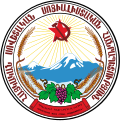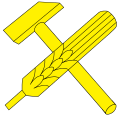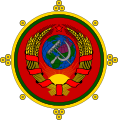hammer and sickle
Hammer and sickle is the best known and most common symbol of Marxism-Leninism . It was developed after the Russian October Revolution and stands for the unity of the working class ( hammer ) and peasant class ( sickle ). Since then it has been adopted in flags and emblems of numerous communist parties and organizations as well as by communists of ruled states.
Depending on the context, the use of this symbol is prohibited in several states such as Latvia , Lithuania , Moldova , Ukraine and Indonesia ; there was also a brief ban in Poland .
history
The symbol was designed by the painter Yevgeny Ivanovich Kamsolkin (1885–1957) on May 1, 1918 for a festival decoration in Moscow. The 5th All-Russian Congress of Soviets declared the symbol to be the state emblem of Soviet Russia a few months later, and so it was then also incorporated into the state coat of arms of the Soviet Union and the Union Republics .
Since the collapse of the Eastern Bloc around 1990, the global use of hammer and sickle has declined sharply. In the Russian Federation, however, the symbol experienced a renaissance - detached from its original ideological meaning. For example, flags with hammer and sickle are used again in parades of the Russian armed forces . The symbol from the Soviet era has also been preserved in the state coat of arms of the internationally unrecognized Transnistria . The French Communist Party (PCF), however, parted ways with the hammer and sickle in 2013.
Examples
Hammer, sickle and ears of wheat in the state coat of arms of the Soviet Union
Flag of the Communist Party of Vietnam
Flag of the Communist Party of Lebanon
Logo of the Fourth International
Coat of arms of the Armenian SSR
Coat of arms of the Azerbaijani SSR
Logo of the historical KPD
National flags with hammer and sickle
In these national flags the hammer and sickle are or have been used:
| flag | date | function |
|---|---|---|
 |
1943-1944 | Flag of the People's Republic of Albania |
 |
1931-1937 | Flag of the Chinese Soviet Republic |
 |
1923-1991 | Flag of the Soviet Union |
 |
since 1990 | Flag of Transnistria |
Prohibition
The hammer and sickle symbol, as well as the red star and other communist symbols or the hymn of the Soviet Union , are used in Latvia , Lithuania (since 2008), Indonesia (since 1966) and Ukraine (since 2015), as well as Moldova (since 2012) banned. Such a ban has existed in Poland since 2009, but with the ruling of the constitutional tribunals on July 19, 2011, it was declared unconstitutional and considered null and void from the start. The ban in Hungary was also lifted again in 2013.
Modifications
Various organizations and states used or related - influenced by hammer and sickle - modified symbols in which hammer or sickle as symbols of the working and peasant classes are replaced by other images and / or one or more other elements as symbols of other classes (e.g. B. Intelligence ) are added.
In the flag of Angola , the symbolic statement is retained in terms of content and graphics, but vice versa: the peasants 'semicircular sickle is replaced by the workers' cogwheel and the workers 'straight hammer by the farmers ' machete . In Angola's coat of arms the hoe stands for the peasant class, the machete stands for the struggle for independence, the cog wheel for the working class and the open book is supposed to represent the country's intelligence.
In the Hungarian coat of arms , the hammer was used as a symbol for the working class and the ear of wheat as a symbol for the peasants from 1949 to 1956 . This coat of arms was also used in the Hungarian national flag during the same period .
In the former flag (1970–1991) of the People's Republic of the Congo (today's Republic of the Congo), the hammer crossed with a hoe stands for the union of the peasants with the industrial workers.
In the national coat of arms of the German Democratic Republic , the symbol's statement was made by the hammer (working class), the circle (intelligence) and instead of the sickle the wreath of ears (farmers). It symbolized the “ workers and peasants state ” in alliance with the “ intelligentsia ”.
The Chinese Communist Party uses a slightly modified symbol. The handle of the sickle is rounded, the yellow a little darker.
The emblem of the Juche ideology is composed of a hammer, scythe and the traditional Korean brush (representative of writers and intellectuals). The ideological symbolism is thus related to that of the GDR coat of arms. Here the symbol can be seen on the flag of the Labor Party of Korea .
In the flag and in the coat of arms of Mozambique there is a strong modification of hammer and sickle, the hoe symbolizes the class of peasants, the Kalashnikov stands for the struggle for independence and the open book is supposed to represent the intelligence of the country.
In the South Siberian Tuvinian People's Republic (a satellite state of the Soviet Union), which existed from 1926 to 1944 and emerged from the Republic of Tannu-Tuva , the rake stood for the working class and the semicircular sickle for the farmers.
The symbol of the Maoist, later Hoxhaist Communist Party of Germany / Marxist-Leninists (KPD / ML) and its successor organization “Red October” represented the hammer for the working class, the semicircular sickle for the peasants and the rifle for the revolution .
In the symbol of the Communist Party of Britain , the hammer stands for the working class and the dove for peace.
The symbol of Otto Strasser's national Bolshevik Black Front showed a crossed hammer and sword , modeled on the hammer and sickle.
In the coat of arms of the Far Eastern Republic , a satellite state of Soviet Russia, which existed from 1920 to 1922 , the anchor , shovel , sheaf and scythe stood for the unity between fishermen and miners .
The Myanmar flag, used from 1974 to 2010 , represented a rice ear for the peasants and the cog for the working class.
Non-communist use
On banknotes and coins of the German Reich , the Weimar Republic and the Third Reich , hammer, sickle, plow or bundle of ears of corn were often found on the stylized worker. The symbolization of power and strength based on work was essential here. It was therefore no coincidence that the banknotes also displayed symbols that could be viewed as warlike and that embody defensibility, such as B. the national allegory Germania with shield and sword . In pairs, the hammer and sickle are rarely found on German money signs until 1945, for example on the 5 Mark Reich cash receipt - issued by the Reich Debt Administration in accordance with the law of April 30, 1874 .
It was also controversial with the coat of arms of the Republic of Austria .
Representation as characters on the computer
Unicode
The hexadecimal Unicode of the hammer and sickle symbol is U + 262D. The result is ☭ or as a graphic symbol ![]() if the Unicode character set used does not contain this character.
if the Unicode character set used does not contain this character.
Some operating systems or graphical user interfaces such as GNOME allow hammer and sickle to be displayed as special characters while holding Strg+ Shift+ u, followed by the code 262D.
HTML
Entering the string & # 9773; in HTML code also results in the symbol being displayed as characters.
See also
literature
- German
- Harry Pross : Political Symbolism. Theory and practice of public communication (= Urban pocket books. Series 80, Bd. 866). Kohlhammer, Stuttgart a. a. 1974, ISBN 3-17-002033-1
- Jürgen Koppatz: Bank notes of the German Empire. Transpress - Publishing House for Transport, Berlin 1983.
- Karlheinz Weißmann : Black flags, rune symbols. The development of the political symbolism of the German right between 1890 and 1945. Droste, Düsseldorf 1991, ISBN 3-7700-0937-1 (At the same time: Braunschweig, Universität, dissertation, 1989).
- Peter Diem : The symbols of Austria. Time and history in signs. Kremayr & Scheriau, Vienna 1995, ISBN 3-218-00594-9 .
- English
- David Lempert: Daily Life in a Crumbling Empire: The Absorption of Russia into the World Economy (= Eastern European Monographs 444). 2 volumes. Columbia University Press, Boulder CO 1996, ISBN 0-88033-341-3 .
Web links
Individual evidence
- ↑ Lexikon der Kunst , Leipzig 1968-78, Vol. 2, p. 179
- ↑ Erhard Stölting: Change and Continuity of Institutions. Russia - Soviet Union - Russia. In Gerhard Göhler: Institutional Change . Leviathan, 16/1996, 181-203, at pp. 189-190.
- ↑ Isabelle de Keghel: The state symbolism of the new Russia. Traditions - Integration Strategies - Identity Discourses. Lit Verlag, Hamburg / Münster 2008, p. 149.
- ↑ news.bbc.co.uk (English)
- ↑ www.welt.de
- ↑ german.ruvr.ru
- ↑ de.rian.ru
- ↑ www.foxnews.com ( Memento of the original dated December 2, 2009 in the Internet Archive ) Info: The archive link was inserted automatically and has not yet been checked. Please check the original and archive link according to the instructions and then remove this notice. (English)
- ↑ Dz.U. 2011 no. 160 poz. 964; Wyrok Trybunału Konstytucyjnego z dnia 19 lipca 2011 r. sygn. act K 11/10. In: sejm.gov.pl. July 19, 2011, accessed November 24, 2013 (Polish).
- ↑ Hungary: Swastika and Red Star allowed again. In: derStandard.at. February 20, 2013, accessed December 3, 2017 .
- ↑ Complete Flags of the World. 6th edition, DK, London / Delhi 2014, p. 139 (English).
- ^ André G. Bordeleau: Flags of the Night Sky. When Astronomy Meets National Pride. Springer, New York 2014, pp. 319-320 (English).
- ^ M. Anne Pitcher: Transforming Mozambique. The Politics of Privatization, 1975-2000. Cambridge University Press, Cambridge / New York 2002, p. 236 (English).
- ^ Arnold Rabbow: Visual symbols as appearance of non-verbal journalism. Dissertation, University of Münster 1968, p. 103.
- ^ Mathias Brodkorb: hammer and sword. Weißmann on "political symbolism". Right end of the line, 23 November 2010.



























